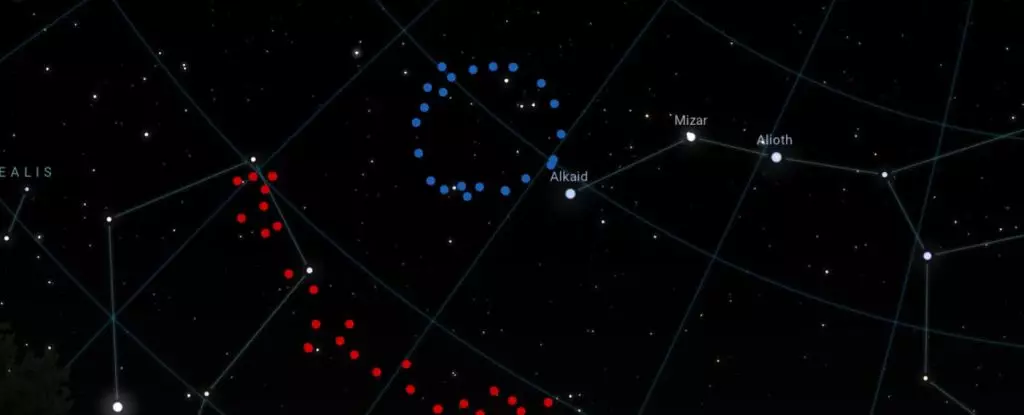In a revelation that shakes the very foundation of our understanding of the Universe, astronomers have unveiled an astonishing structure: the Big Ring. Spanning a mind-boggling 1.3 billion light-years in diameter, this near-perfect ring of galaxies challenges existing cosmological paradigms and compels scientists to reconsider the accepted narratives about cosmic evolution. Spearheaded by the relentless efforts of astronomer Alexia Lopez from the University of Central Lancashire, this groundbreaking discovery, presented at the 243rd meeting of the American Astronomical Society in 2024, marks a pivotal moment in astronomical study.
The Big Ring’s structure is unlike any previously documented cosmic formation. It is not merely an enormous aggregation of galaxies; rather, it has an intricate shape that resembles a corkscrew rather than a traditional spherical model often associated with Baryon Acoustic Oscillations (BAOs). BAOs represent sonic waves’ trajectories from the early Universe, which would suggest a certain uniformity across cosmic structures. Yet, the Big Ring and its sibling structure, the Giant Arc, seem to be whispering secrets that our current scientific framework cannot interpret.
A Challenge to the Cosmological Principle
The essence of cosmology rests upon the Cosmological Principle, which asserts that the universe should appear homogeneous when observed on large scales. This principle is foundational, suggesting a universe where matter is consistently distributed across various cosmic regions. However, Lopez’s findings fundamentally contradict these long-held beliefs. The current theoretical maximum for cosmic structures is estimated to be around 1.2 billion light-years, but both the Big Ring and the Giant Arc exceed this threshold, the latter being almost three times larger.
Lopez poignantly states, “We expect matter to be evenly distributed everywhere in space… yet both of these structures are much larger.” This revelation urges us to delve deeper into the implications of our observations, rekindling the debates surrounding cosmic topology and the limits imposed by both our measurements and theoretical constructs.
Theoretical Implications and Speculative Models
As we grapple with the enormity of these discoveries, the question muddles about what they imply for the existing cosmological model. Are we witnessing anomalies that challenge the very nature of the Big Bang Theory? One intriguing hypothesis is Roger Penrose’s concept of conformal cyclic cosmology, where the Universe undergoes endless cycles of expansion. Such models suggest that structures, akin to the Big Ring, may emerge, although critics note that these theories harbor their own set of inconsistencies.
Another possibility lies with the concept of cosmic strings—hypothetical defects in spacetime that may have formed during the Universe’s infancy. These “wrinkles” in spacetime could be akin to taut strings generated during cosmic inflation. Though observational evidence for such structures is limited, the theoretical groundwork suggests their dynamics could indeed spawn the type of cosmic formations we now observe with the Big Ring.
The Search for a Cosmic Blueprint
The cosmic community stands at a crossroads, yearning to decipher the meaning behind these colossal formations. Despite the daunting task ahead, there lies a glimmer of optimism. Should we uncover more arrangements akin to the Big Ring scattered throughout the cosmos, our understanding of galactic evolution and structure could undergo a radical transformation. The prevalence of such formations could signify an underlying structure to the Universe that extends beyond the randomness we have attributed to galaxy formation until now.
With astronomers illuminating paths to new discoveries, a culturally rich tapestry awaiting exploration beckons scientists to extend their observational reach. As Lopez emphasizes, “From current cosmological theories, we didn’t think structures on this scale were possible.” The persistence of the human imagination, especially in realms as unfathomable as the cosmos, demands that we continuously question accepted knowledge and seek out previously uncharted territories.
As we reflect on the significance of the Big Ring, it becomes apparent that this discovery transcends mere scientific inquiry. We find ourselves standing on the precipice of a deeper philosophical conundrum—what if the universe is far more complex than our best models predict? The unraveling of cosmic mysteries may very well redefine our place within the vast expanse of space and time, unearthing truths that challenge our perception of reality itself.


Leave a Reply